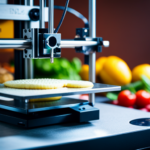In the rapidly evolving realm of food 3D printing, identifying and connecting with the right target market is crucial for success. As the industry continues to gain momentum, understanding consumer preferences, market trends, and niche opportunities becomes increasingly vital.
This article delves into the strategic process of pinpointing your target audience in the food 3D printing landscape, offering valuable insights and practical guidance for developing effective marketing strategies.
Understanding the Food 3D Printing Landscape
Understanding the food 3D printing landscape involves analyzing the current market trends and technological advancements in additive manufacturing for food products. The technology advancements in 3D food printing have significantly evolved, enabling the production of intricate and customized food products. These advancements have resulted in improved precision, speed, and variety in food printing, thereby opening up new possibilities for the industry.
Market positioning strategies play a crucial role in leveraging these technological advancements. Companies need to align their market strategies with the capabilities of 3D food printing technology to meet consumer demands effectively. This involves identifying niche markets, understanding consumer preferences, and developing customizable solutions to cater to specific dietary needs or flavor profiles.
Researching Consumer Preferences and Needs
Researching consumer preferences and needs in the food 3D printing industry requires a comprehensive understanding of market demands and technological capabilities to effectively cater to niche markets. To conduct thorough research, it is essential to analyze consumer behavior and preferences through market research methodologies. This involves gathering and analyzing data related to consumer preferences, dietary restrictions, and cultural food habits.
Additionally, understanding the following key aspects is crucial:
-
Customization and Personalization: Identifying the level of customization desired by consumers, whether it’s personalized nutrition, unique shapes, or tailored flavors.
-
Health and Nutrition: Researching the demand for healthier and nutritious food options, considering factors such as organic ingredients, allergen-free products, and specific dietary requirements.
-
Convenience and Accessibility: Determining the convenience factor desired by consumers, such as ready-to-eat 3D printed meals, on-the-go snacks, and easy-to-prepare food items.
-
Sustainability and Ethical Consumption: Investigating consumer preferences for sustainable and ethically sourced ingredients, as well as environmentally friendly packaging.
Understanding these consumer insights will provide valuable input for the development of food 3D printing products that align with market demands. This knowledge will also aid in identifying potential niche markets with unmet needs and preferences.
Identifying Potential Niche Markets
As the food 3D printing industry continues to evolve, identifying potential niche markets becomes crucial. These niches may include catering to unique dietary preferences, such as vegan, gluten-free, or allergen-specific options, which traditional food services may struggle to accommodate.
Additionally, customized event catering, where personalized designs and flavors are possible through 3D printing, presents a unique opportunity for targeting specific consumer segments.
Unique Dietary Preferences
The identification of potential niche markets within the food 3D printing industry necessitates a thorough understanding of unique dietary preferences. This is crucial for catering to a diverse range of customer needs and preferences. When considering unique dietary preferences, the following aspects are essential to address:
-
Plant-Based Diets: With the growing popularity of plant-based diets, offering 3D printed food options that cater to this demographic can be a lucrative niche market.
-
Allergen-Free Options: Providing allergen-free 3D printed food items can appeal to individuals with specific food allergies or intolerances, broadening the customer base.
-
Customized Nutrition: Tailoring 3D printed food to meet specific nutritional requirements, such as high protein or low carb, can attract health-conscious consumers.
-
Personalized Dietary Restrictions: Offering customizable options to accommodate various dietary restrictions, such as gluten-free or vegan, can enhance market competitiveness.
Understanding and catering to these unique dietary preferences can significantly expand the target market for food 3D printing technology, opening up new opportunities for innovation and growth.
Transitioning into the subsequent section about ‘customized event catering’, it is evident that understanding unique dietary preferences is pivotal in effectively meeting the demands of diverse events and functions.
Customized Event Catering
To identify potential niche markets in customized event catering within the food 3D printing industry, understanding specific event requirements is essential. Customized event catering using food 3D printing technology allows for personalized menus tailored to meet the unique preferences and dietary needs of event attendees. This presents an opportunity to cater to niche markets with specialized dietary requirements such as gluten-free, vegan, or allergen-free options.
Additionally, food 3D printing enables culinary innovation, allowing for the creation of visually stunning and intricately designed dishes that can cater to events seeking a high-end, avant-garde culinary experience. Understanding the demand for personalized, innovative culinary experiences at events can help businesses identify and target niche markets within the customized event catering segment of the food 3D printing industry.
Analyzing Competitors and Industry Trends
In order to gain a competitive edge in the food 3D printing industry, it is essential for businesses to thoroughly analyze both their competitors and the current industry trends. This analysis provides valuable insights that can be used to refine business strategies, identify opportunities, and stay ahead of the curve.
Here are some key aspects to consider when analyzing competitors and industry trends:
-
Technology Advancements: Stay abreast of the latest developments in 3D food printing technology to assess how it can impact your business and production processes.
-
Competitive Landscape: Conduct a comprehensive analysis of your direct and indirect competitors to understand their strengths, weaknesses, market positioning, and potential threats they pose.
-
Market Trends: Monitor consumer preferences, dietary trends, and shifts in food consumption patterns that could influence the demand for 3D printed food products.
-
Industry Analysis: Keep a close eye on regulatory changes, industry standards, and emerging business models within the food 3D printing sector to adapt and innovate accordingly.
Developing Customer Personas for Targeting
Developing customer personas for targeting requires thorough research and analysis to understand the diverse preferences and behaviors of potential consumers in the food 3D printing industry. Customer behavior and market segmentation are crucial components in this process. By delving into customer behavior, it becomes possible to identify patterns and trends that can inform the creation of accurate customer personas.
Market segmentation further aids in understanding the distinct groups within the larger consumer base, allowing for more targeted and effective marketing strategies.
To develop customer personas, it is essential to gather data on various factors such as demographics, psychographics, purchasing behavior, and needs. This information can be sourced from surveys, interviews, and market research. By analyzing this data, businesses can identify commonalities and differences among their potential customers, enabling the creation of detailed and accurate customer personas.
These personas serve as fictional representations of the different customer segments, providing insight into their motivations, preferences, and pain points. By leveraging these personas, businesses can tailor their products, marketing messages, and overall strategies to effectively engage with and meet the needs of their target market.
Refining Marketing Strategies for Target Audience
Now that we have identified our target audience through customer demographic analysis and developed customer personas, the next step is to refine our marketing strategies to effectively reach and engage with this audience.
This involves tailoring our content, messaging, and promotional efforts to resonate with the specific needs, preferences, and behaviors of our target market.
Customer Demographic Analysis
For refining marketing strategies for the target audience in the food 3D printing industry, it is essential to conduct a thorough customer demographic analysis. Understanding customer behavior and market segmentation is crucial for tailoring marketing efforts effectively.
To refine marketing strategies, consider the following:
-
Age and Gender: Analyze the age range and gender of the potential customers to customize the messaging and product offerings accordingly.
-
Income Level: Understanding the income levels of the target market helps in pricing strategies and determining the affordability of the 3D printed food products.
-
Location: Geographic location plays a significant role in shaping consumer preferences and dietary habits, making it essential to tailor offerings to specific regions.
-
Lifestyle and Interests: Identifying the lifestyle and interests of the target audience aids in creating personalized marketing campaigns and developing products that resonate with their preferences.
Tailoring Content for Audience
Tailoring content for the audience in the food 3D printing industry involves crafting marketing strategies that resonate with the identified demographic factors, thereby ensuring the effective communication of product value and relevance to potential customers.
Audience engagement is a critical aspect of this process, necessitating the creation of content that captures the attention of the target market and encourages interaction.
Content personalization further enhances the effectiveness of marketing strategies by addressing the specific needs and preferences of the audience. By tailoring content to align with the interests and concerns of potential customers, businesses in the food 3D printing industry can establish a meaningful connection with their target market and foster a sense of relevance and value.
This approach facilitates the development of strong relationships with customers and enhances the overall effectiveness of marketing efforts.
Frequently Asked Questions
How Can Food 3D Printing Technology Be Integrated Into Existing Restaurant or Food Service Operations?
Integrating food 3D printing into existing restaurant or food service operations presents challenges such as equipment compatibility and staff training. However, it offers operational benefits like customization, efficiency, and potential cost savings.
What Are the Potential Regulatory Challenges and Considerations for Introducing 3D Printed Food Products Into the Market?
Navigating the introduction of 3D printed food products into the market poses regulatory challenges, requiring meticulous attention to food safety and consumer acceptance. Understanding and complying with food industry regulations is crucial for successful market introduction.
How Can Food 3D Printing Be Used to Address Specific Dietary Restrictions or Nutritional Needs of Consumers?
Customized diets and nutrient customization are pivotal in addressing specific dietary restrictions and nutritional needs of consumers. Food 3D printing offers a unique opportunity to tailor food products to meet individual health requirements, promoting personalized nutrition.
What Are the Potential Ethical and Sustainability Implications of Using 3D Printing in the Food Industry?
Ethical implications of 3D food printing involve questions of food safety, labor displacement, and equitable access. Sustainability considerations pertain to resource usage, waste management, and environmental impact. These should be carefully evaluated and addressed.
How Can Food 3D Printing Be Used to Create Personalized and Customizable Dining Experiences for Consumers?
Food 3D printing enables personalized and customizable dining experiences for consumers. Culinary innovation allows for intricate designs, tailored nutrition, and unique flavor combinations. This technology revolutionizes the food industry, offering endless possibilities for creative gastronomic experiences.
Conclusion
In conclusion, identifying the target market in the food 3D printing industry is crucial for success. Researching consumer preferences, identifying niche markets, analyzing competitors, and developing customer personas are essential steps in this process.
By refining marketing strategies for the target audience, businesses can effectively position themselves in the market. An interesting statistic to note is that the global 3D food printing market is projected to reach $525.6 million by 2027, indicating the potential growth and opportunities in this industry.


